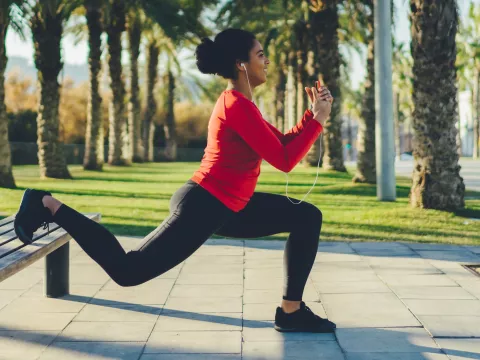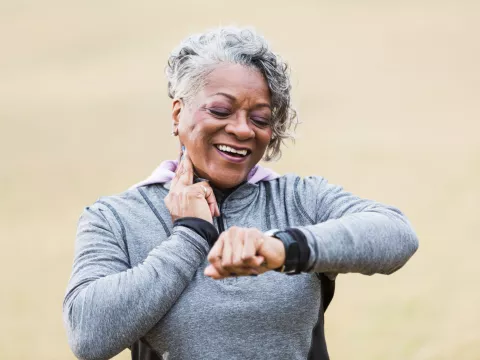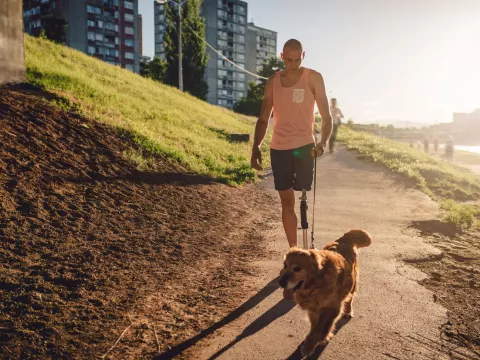- AdventHealth

Choose the health content that’s right for you, and get it delivered right in your inbox.
As a runner, it’s essential to develop strength along with aerobic capacity. Strong runners race faster, finish with a better kick and are injured less frequently.
Bodyweight strength training can help you make the most of your running by allowing you to stay healthy and run more consistently, no matter how many miles you log each week.
Juan Madrid, a physical therapist at AdventHealth, understands the benefits of bodyweight training for runners: “I’m a big believer in mastering your own body weight. Runners can get all of their strength training done at home. Running is a single limb activity; it’s important to improve single limb strength and stability.”
Bodyweight training can be done just about anywhere, making it easy to fit into your schedule. With added convenience and accessibility, you’re more likely to follow your plan and find the time to do it.
Benefits of Strength Training
While strength training has become more widely accepted as a necessity for endurance athletes, you still may think of it as “extra” or cross-training rather than an essential component to your success.
Consider the following:
- Running is a high impact sport. On average, about 40 – 50% of runners are injured every year, and an even higher percentage of those runners have injuries that recur.
- A weak or inefficient muscle anywhere means that other muscles or tendons and ligaments will have to take over. Over time they can get overloaded and break down.
- Strength training will make you more resilient and allow for better body control that helps with form and efficiency.
If you don’t make time for strength training while you’re healthy, an injury may force you to reconsider. This is where bodyweight exercises can be extremely useful — they’re easy to customize to your personal routine.
Establish Your Strength Training Goal
To get the most from any strength routine, you need to establish your training goal. Once you determine the needs your strength training will fulfill, you can select from a variety of exercises and put them together into a routine. As you build strength, your routine should also follow a progression so you continue to improve.
Most runners will focus on one of the following goals:
- Injury prevention and/or form improvement: This requires a focus on stability. Exercises here will tend to be core-focused and use less resistance.
- Strength and power: Want to improve your kick and running economy? Use bodyweight training that focuses on larger muscle groups with more resistance.
- Cardiovascular training: This is not an ideal use of strength training for runners, but if you’re struggling with being stuck at home, you can create a routine that incorporates high-intensity exercises to improve aerobic fitness.
Although many exercises overlap in these three categories, each has subtle but important differences. Establishing your priorities not only helps you select the best set of exercises, but also gives you a more concrete goal to stay motivated.
Choose Your Exercises
There are nearly an endless variety of exercises that you can do at home and a quick search online can help you explore the possibilities. The exercises listed below are only a small sampling, but it’s best to start with a short, simple routine rather than overwhelming yourself with dozens of exercises.
For injury prevention and form improvement, consider some of the following:
- Bicycle
- Bird dog
- Glute bridges
- Hip thrusts
- Lunges in different planes of motion
- Planks and plank variations
For strength and power, compound movements will be most effective:
- Lunges (static or walking)
- Pull-ups/chin-ups
- Pushups
- Single leg deadlifts
- Single leg squats
- Squats and squat variations
If your goal is to improve cardiovascular fitness, you’ll need to increase the intensity of your routine:
- Burpees
- Jumping jacks
- Jump rope
- Mountain climbers
- Plyometrics
- Split lunge jumps
Madrid suggests even more valuable exercises for runners, like, “single-leg squat progressions, single-leg bridges, single-leg calf raises, single-leg Romanian deadlifts and Copenhagen plank progressions for the inner thigh.”
Design a Routine That Meets Your Needs
As you create your bodyweight routine, you’ll need to think about each of the following:
- Number of exercises
- Order of exercises
- Number of sets
- Recovery time between exercises and sets
Bodyweight routines should go from simple to complex, and from general to specific. Start with exercises that are easier and more general (like a plank or bicycle), and move toward exercises that are more running specific (such as lunges). Since running is upright and involves a series of one-legged stances, exercises that resemble that would be the most running-specific. Core work or other exercises done on the floor can be done first.
Exercises are grouped into sets which can be increased as you progress, as can the difficulty of the exercises themselves. If you are new to strength training, start with 1 or 2 sets. More advanced athletes can build up to 3 or 4. If you are training for injury prevention, allow adequate rest between sets, but if your goal is cardiovascular fitness then minimize or eliminate rest to keep your heart rate high. Bodyweight training for strength and power will fall somewhere in the middle.
With any strength routine, remember to start small to build consistency and gain confidence. It’s much easier to add exercises and sets as you improve, rather than being disheartened by trying to do too much, too soon. Bodyweight training is accessible for everyone and can easily become an integral part of your training!
Recover, Restore and Rebuild With Expert Care
The AdventHealth Sports Med & Rehab team can not only help you recover from injuries, but work to prevent them altogether. Learn more about our variety of services here.





